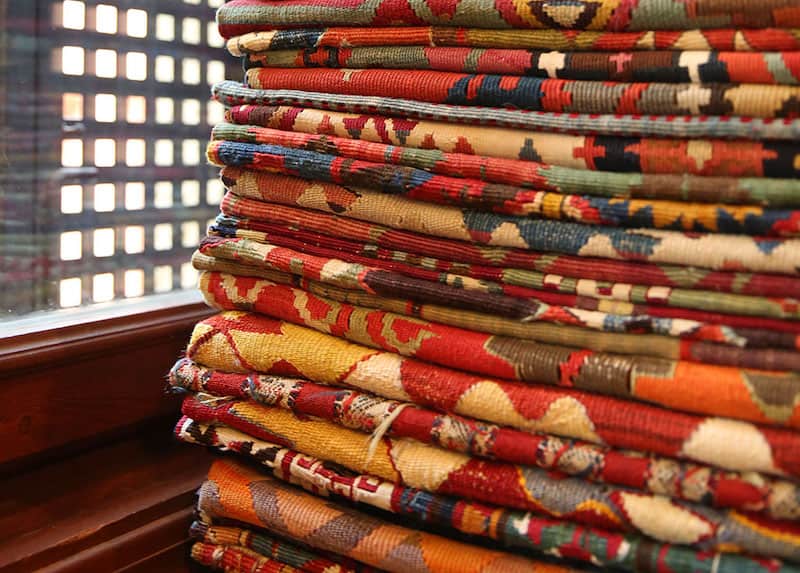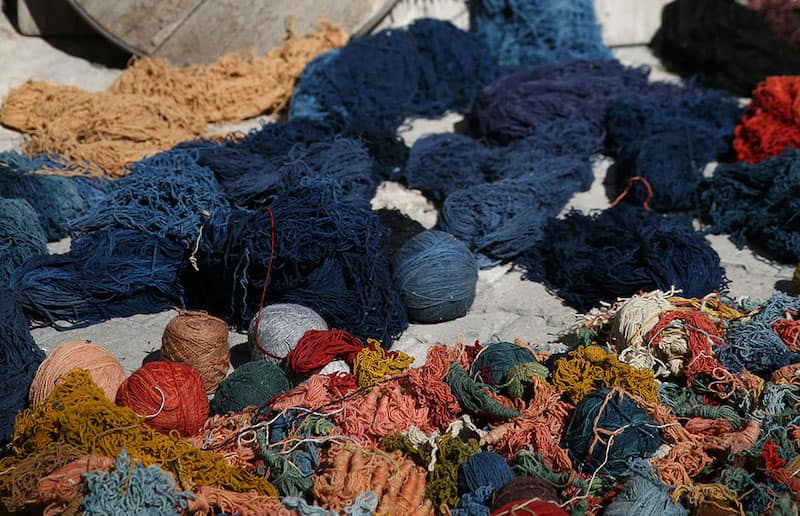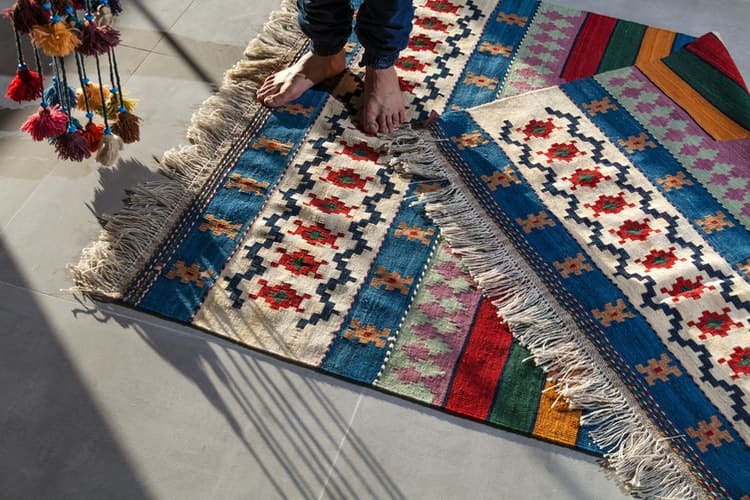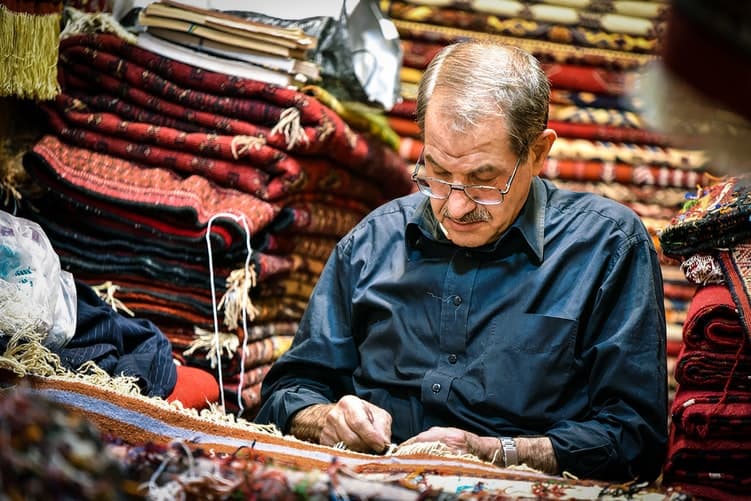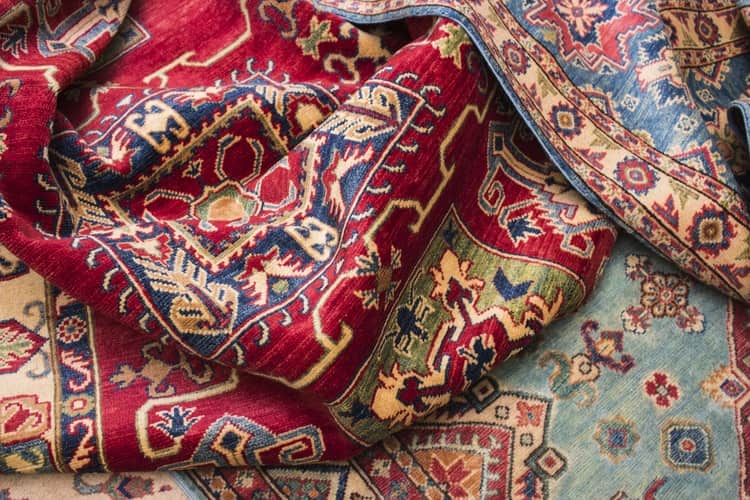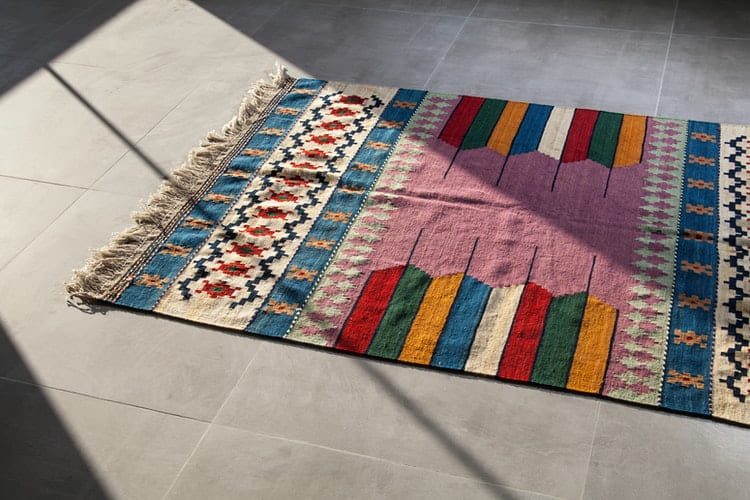By Bingül Gündaş
Throughout history, man has insulated his home against fierce heat, bitter cold, snow and rain by weaving all kinds of clothing, covers and trappings. From such modest needs, the flat-weaving culture has developed. The woven fruits of these simple nomadic and village looms we know today as kilim.
Starting from the simplest forms, these textiles developed from the most basic items of utility to the most elaborate artefacts of prestige and decorative beauty, as symbols of group identity. Over 8,000 years ago in Anatolia or today’s modern Turkey, women may have been weaving kilim as functional everyday items. They were used for floor coverings, cushions, storage bags, tent decorations, saddlebags and so on.
Its lightweight and easy care made it popular among nomadic tribes. The finest of the kilim was kept for dowry and allowed the weaver a certain advantage in her marriage prospects. Up to the beginning of this century, some of the same designs that were woven by these ancient civilizations of Anatolia were still being copied and passed down to the next generation.
A kilim is not a rug! The kilim is a Turkish word that actually refers to the way something is made; that is, referring to the weaving technique. “Tapestry weave” and “flat-weaving” are the closest terms to describe it. Zili, sumak, palaz, and jajim are the names given to various weaving techniques used in Anatolia.
In kilim technique, patterns are produced by winding the coloured weft threads around pairs of warps. In jajim, zili, and palaz, three kinds of threads are woven together: warps, coloured wefts, and other colored threads. From the Çatalhöyük people through the Hittites, the Romans, the Greeks, the Lyckians, the Selcuks, the Turkmens, and the Ottomans, the women of Anatolia have preserved this art form and each one has added her own culture, her way of life, and her expression to the art of kilim-weaving.
The geometric motifs in these antique tribal rugs and weavings evolved directly on the loom. Traditional designs, whether religious, talismanic or totemic, were passed from one generation to the next, with each weaver creating subtle variations that reflected her own artistic personality.
Ancient icons of universal belief
Seeking the origin of certain designs is a favorite but hazardous pastime of Western collectors. For example, the motifs and symbols of kilim have been analyzed and catalogued according to their most recognizable and common characteristics. All of this was done in an attempt to follow logical procedures of investigation, trying to find a meaning which might be locked within the chaotic array of predominantly geometric composition. What is certain is that the traditions which determine the use of motifs and patterns in the flat-weaves have a colorful oral ancestry, wherein the names for a pattern or motif have been communicated verbally from mother to daughter and from weaver to weaver over the generations.
And, any system of entirely verbal instructions is, by nature, subject to change, distortion, interpretations and meanings that will be altered and misunderstood over the ages. Like the traditions of tribal folklore and history, it too has been lost, defeated by education and commercialization, urbanization and a general loss of tribal identity.
When nomads settled into village life, they often turned from their old flat-weave traditions to pile-rug production. How natural that they should include flat-weave motifs and details in their new weavings! The key to understanding the evolution of any textile motif is determining the medium in which it originated. Only then can we separate pure forms from adaptations.
But what are the clues? If we find similar forms in different kinds of tribal weavings, how can we decide which came first? There is no direct answer or discipline that explains the development of, and meaning behind, the patterns and motifs found in a kilim.
It involves three connected processes:
Analyzing the structure of the flat-weaving and the resulting limitations on pattern and geometry.
Then, a study of tribal groups; their migrations, lifestyle, religion, beliefs and superstitions.
Finally, putting together how such cultural patterning evolved into family traditions and the folklore of settled villagers.
Patterns, motifs and limitations
The very process of weaving itself limits the types of patterning which are possible. The most simple form of weaving is “balanced plain” weave. The colours of both warp and weft threads will show on the surface. The weaver’s desire to break up these stripes led to the creation of colour, easily achieved using “slit-weave”. In this way, colours form blocks which may then be coordinated into patterns, rather than mere stripes.
To keep the slits small, only triangles, diamonds, 90 or 45-degree angles and stepped motifs can be produced. Subsequently, more sophisticated motifs developed from these simple geometric patterns. This motif development can be seen in the nomadic tribes of Central Asia.
The path of Oghuz Turks is clearly related to the areas where slit-weaving has evolved as the predominant kilim weaving technique. The people of central Anatolia, that is, the Shahsavan and Qashqai, all weave kilim with similar patterns and motifs. The Kazakh and Kirgiz tribes make reed screens for their “yurts” during summer, to protect their tents. These reed screens are decorated with colored wool, which has not been spun, in stepped geometric patterns that are similar to many Turkic kilim patterns.
A change, from reed screens to woven woollen kilim, took place when these nomads migrated across the Iranian plateau to Anatolia where the slender steppe grass, used to make reed screens, was no longer available. They adapted, making flat-weaves which used the same traditional patterns and motifs with the wool from their sheep. Building on the basic technique of slit-weave, more complex forms of weaving and patterning were applied.
At this point, it is also important to mention the eastern Sufi and general Islamic philosophy and their influence. The concept of the ever-present duality, found in life and nature, black and white, winter and summer, life and death, good and evil, is present in the design elements of tribal flat-weaves.
Belief and superstition
Buddhism, Islam and Christianity have been the three main religions of the kilim weaving world. And, the symbols relating to these beliefs have been deeply engraved in the creativity of the rug weaver. The relationship between positive and negative forms in the pattern is most obviously expressed in the Taoist “yin” and “yang” symbol.
However, Sufi philosophy also embraces the belief of balance in everything and Sufi ideology has imposed a powerful influence on design. This influence can still be seen today in many Turkic kilim designs.
The evolution of the cross symbol may be associated with the Christian cults. But, the significance of this symbol has been misconstrued since the cross is simply the easiest design to draw. From Islam, there have come restrictions on figurative representation and a fascination with recurrence of numbers. As an example, the number five is associated with the five caliphs, the hand of Fatima with five fingers, and the five pillars of Islam. Prayer rugs are always recognizable, for the design directly relates to the Islamic faith. Superstitions, on the other hand, continue to play an active role in the lives of the Muslim people. A residue of pre-Islamic sensibilities and extensive superstitious beliefs co-exist happily.
The protective and mystical properties embodied in textiles are more important than their complex social uses and decorative qualities.
Their motifs, patterns and designs work on three levels:
As family or tribal standards.
As talismans to ward off evil and bring good luck.
As an expression of weaver’s aesthetic sensibilities.
One of the most popular designs to ward off the “evil eye” is a central red medallion with wavy lines, depicting energy flowing to and from the talisman. So, a correctly made textile will have the power to protect not only the weaver and her family but the weave itself!
Tradition and folklore
The nomadic and village lifestyle of the people living within flat-weaving communities has remained close to nature. Their cycle of life is simple and their oral history has been told by one generation to the next, sung in the private songs of the family elders and by shamans in their recitations.
Nomads have few possessions and their heritage is represented by their tents, animals, cooking pots, few clothes, and rugs. Their tribal traditions, beliefs and superstitions have remained the same for hundreds of years. With the urbanization of nomads and the change to a settled agrarian lifestyle, the original tribal traditions, that related closely to migration, evolved into village folklore.
The secret language, of beliefs, potions, signs and skills including the motifs of the kilim, is handed down from mother to daughter. The desires of, and aspirations of, settled village people became more immediate, and as wealth accumulated with possessions of goods and land, so the need for continuity and the wish for good fortune and fertility increased. Kilim functioned as a form of visual communication, an expression of the hopes and wishes of the weaver in the form of motifs and symbolic talismans. Anatolian kilims are the most famous for their symbols and their patterns with folkloric meanings. You can read about the significance of kilim symbology here. The motifs of traditional kilim patterns are imbued with meaning, passed down for generations.
Birth KILIM Motifs
Elibelinde: “Goddess figure.” Appearing often in an easily recognizable form, sometimes with a child depicted in the womb. The symbol of life, birth and the desire for the birth of a child. This “elibelinde” motif appears in single form and mirror image in both fields and borders.
Koç boynuzu: “Ram’s Horn.” The eternal strength of the ram’s horn depicts masculinity, male fertility, power and heroism. In weaving this motif, the woman is hoping her husband will be strong in every aspect and his strength will last the test of time. This motif is thought to be derived from a spiral, which indicates eternity.
Bereket: “Abundance/Fertility.” The combination of the previous two motifs together form this motif. It symbolizes fertility. Multi-seeded fruits, like pomegranate and crops, also signify fertility.
Insan: “Human figure.” Used to depict the expectation of a child. Used also for remembrance.
Life Motifs
Saçbağı: “Hair band”; Küpe: “Earrings.” These signify the weaver’s desire to marry. The hairband is a wedding ornament, and the earring is a frequent wedding gift.
Bukağı: “Animal fetter.” This cuff shaped motif symbolizes the continuous union of a family. The devotion of lovers and result of the union, birth.
Sandıklı: “Chest.” It represents the trousseau of a bride. From childhood, a girl will prepare for marriage, weaving rugs, bags, and kilims; embroidering handkerchiefs, scarves, and belts; making undergarments and pouches to contain her belongings. These will not be used before her wedding. It also stands for the desire to get married and for having a child. In some cases, it symbolizes death and a coffin!
Aşk ve Birleşme: “Ying-Yang.” Love and uniting. A motif inherited from the Far-East. Symbolizes the wish for the harmonious balance of relationship, harmony between a man and a woman.
Yıldız: “Star.” A motif used to express happiness and fertility. Because of the weaving limitations and techniques, Anatolian kilims often have eight-pointed stars. The six-pointed stars are generally known as “Solomon’s Seal” and are used to symbolize the womb of the mother goddess figures.
Protection and Life Motifs
Su Yolu: “Running Water.” Emphasizes the importance of water for mankind. Without water, there is no life. So, this very important figure is often found incorporated into border designs and represents life itself. Motifs in the form of meanders, clouds and even vases and ewers are expressions of the same theme.
Ibrik: “Ewer.” A motif stylized in the form of a traditional water container. Symbolizes purity, purification and is also a symbol of pregnancy.
Pıtrak: “Burdock.” A motif derived from a prolific plant which is believed to ward off the “evil eye”.
El, Parmak, Tarak: “Hand, finger and comb.” Motifs composed of five dots or five lines are based on the Anatolian belief that the number five; that is, the number fingers on a hand, serves as a protection from spells or the “evil eye”. This motif also represents the hand of Mohammad’s mother Fatima, and is used as a fertility symbol. The comb, on the other hand, signifies the desire to be married, and protects marriage and birth from the “evil eye”.
Muska: “Amulet.” A motif in the shape of written charms which are believed to have magical and religious powers to protect the possessor from external dangers and are generally placed in triangular cases.
Nazarlık: “Evil Eye.” This charm exists in various forms. It is used as a motif to reduce the effect of an evil glance, that may cause misfortune, harm and even death.
Göz: “Evil Eye.” A motif often in a diamond shape, squares and triangles which prevents the harm caused by the “evil eye”.
Haç: “Cross.” A very ancient motif going back to pre-Christian times that also protects against the power of the “evil eye”.
Çengel: “Hook.” Another motif used against the “evil eye”.
Yılan: “Snake.” A motif used with protective purposes. A black snake is a symbol of happiness and fertility.
Ejder: “Dragon.” Derived from mythology, the winged creature is stylized with the feet of a lion and the tail of a snake. It is believed to be the master of the air and water, the cause of lunar eclipse, the guardian of treasures and secret of the universe and the keeper of the tree of life. A very popular design in Caucasian rugs and kilims, it symbolized fertility. A related theme is the fight of the dragon and the Phoenix which is believed to produce fertile rains of spring where the dragon is stylized as a cloud.
Akrep: “Scorpion.” A motif used as a protection against the scorpion. It is sometimes used to represent a dragon.
Kurt Ağzı or Kurt Izi: “Wolf’s Mouth, Wolf’s Tracks.” A protective motif against wolves. As nomadic people were cattle and sheep breeders, wolves were a primary threat.
Canavar Ayağ: “Monster’s Feet.” A local name for the motif symbolizing the dragon.
Afterlife Motifs
Kuş: “Bird.” A motif loaded with many meanings: good luck, bad luck (vulture), happiness and joy, the soul of the dead, women, the expectation of news, power and strength. When birds on the tree of life fly away, the soul is going to heaven.
Çiçek: “Flower.” A motif used at the border of kilims. Usually composed of stylized roses, carnations, tulips and hyacinths, which resemble the garden of Eden. The Tulip is also used to express the expectation of a male child.
Hayat Ağacı: “Tree of Life.” Symbol of man’s wish for immortality or the hope for life after death. The stylization of various plants such as cypress, palm, pomegranate, date, fig, olive, vine, oak, and beech symbolizes the tree of life. Often hung on a wall upside down, because of the belief that roots of the tree are in heaven.
As you can see, kilims represent more than the fabric that has been created from wool, using only colored threads to make a functional or mystical design on the surface. In a sense, the 8,000 years of Anatolian history and culture reside in these motifs and weavings, never to disappear. In fact, the process of encoding family and cultural history continues even today, from mother to daughter, as long as the verbal traditions are alive in Turkey.




